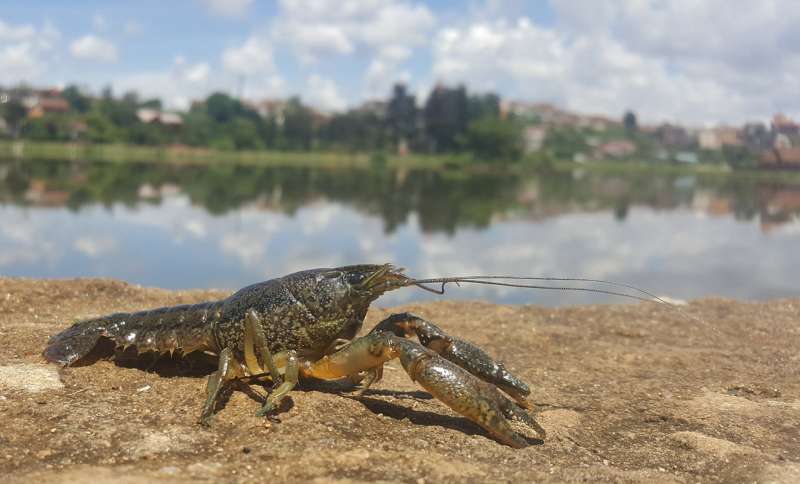A clonal crayfish from nature as a model for tumors

A genome study has proven that all specimen of Marmorkrebs, or marbled crayfish, originate from a single female. About 30 years ago, the original clone evolved in an aquarium. Ever since, the female animals have been able to spread successfully without any help from males, scientists from the German Cancer Research Center (DKFZ) report in a current publication. The clonal genome evolution of the crayfish may also help explain processes in tumors.
Some years ago, a freshwater crayfish that reproduced alone in the aquarium puzzled pet owners and scientists. This could only be explained by a phenomenon called parthenogenesis, a natural form of asexual reproduction. Now, genome sequencing and comparative studies of individual animals have shown that, in fact, all specimen descend from a single mother crayfish. The Marmorkrebs clone is a separate species (Procambarus virginalis), which, as genetic studies have shown, has split from the slough crayfish found in the Everglades (Procambarus fallax) some 30 years ago.
In a current publication, Frank Lyko and his team from the German Cancer Research Center (Deutsches Krebsforschungszentrum, DKFZ) in Heidelberg have provided proof that the all-female offspring of the marbled crayfish is genetically identical. Lyko explains: "We could detect only a few hundred variants in a genome that is larger than the human genome. That is an incredibly small number." The minute variations can be ascribed to natural mutations. The DKFZ researchers counted 3.5 billion base pairs in the crayfish genome, which makes it about seven percent larger than the human genome.
In another part of the study, a scientist in Madagascar additionally examined how well the crayfish is able to spread in the wild via parthenogenesis. Its enormous reproductive success came as a surprise to the scientists. "It was known that the crayfish can establish itself in the wild after releases from the aquarium," Lyko said. "But the news was that it can spread so rapidly and massively."
Apart from subtropical Madagascar, Marmorkrebs can also be found, for example, in Sweden, Japan, Freiburg, Hanover, or Heidelberg. This is evidence of its remarkable adaptability -without any sexual reproduction. According to textbook knowledge, it is precisely the "invention of sex" and the resulting mix of paternal and maternal genes that enlarge genetic variety, thus facilitating rapid adaptation to adverse environmental conditions.
However, although all marbled crayfish are born with the same genes, they are able to adapt to a wide variety of habitats. This is made possible by epigenetic mechanisms. These are regulated by small chemical tags attached to DNA, the genetic substance. Epigenetic mechanisms basically regulate the interpretation of genetic information. They work like switches that turn genes on or off. "Epigenetic variants are often influenced by genetic variants. In Marmorkrebs, however, epigenetic variation is independent, because there is virtually no genetic variation," Lyko explained.
This epigenetic regulation makes the marbled crayfish extremely interesting for tumor researchers. A crayfish for cancer research - what sounds like a play of words in German ("Krebs" is the word for the disease and also for 'crayfish'), has in fact become reality. Lyko said: "Marmorkrebs is an animal that reproduces clonally and therefore represents a model of a central aspect in tumor development." A tumor is also capable of adapting to its environment, for example, by developing resistance against anticancer drugs. Scientists have known for a couple of years, partly from studies at the DKFZ, that epigenetic mechanisms also play a key role in these processes. They can influence cancer risk and the disease course.
A phenomenon called clonal evolution occurs both in Marmorkrebs and in tumors. Lyko: "Tumor genomes also evolve clonally, because they go back to a single original cell." A variety of factors play a role in this process, such as chance mutations in genes, genetic drift, selective pressure and epigenetic adaptation to the environment. The team led by Lyko now wants to use marbled crayfish to further investigate their role. According to Julian Gutekunst, who is the first author of the present publication, the key question to be pursued is "which impact environmental factors have on epigenetics and gene regulation." These findings may enlarge our knowledge about processes in tumors and open prospects for new approaches in tumor treatment.
More information: Clonal genome evolution and rapid invasive spread of the marbled crayfish, Nature Ecology & Evolution, nature.com/articles/doi:10.1038/s41559-018-0467-9
Journal information: Nature Ecology & Evolution
Provided by German Cancer Research Center


















